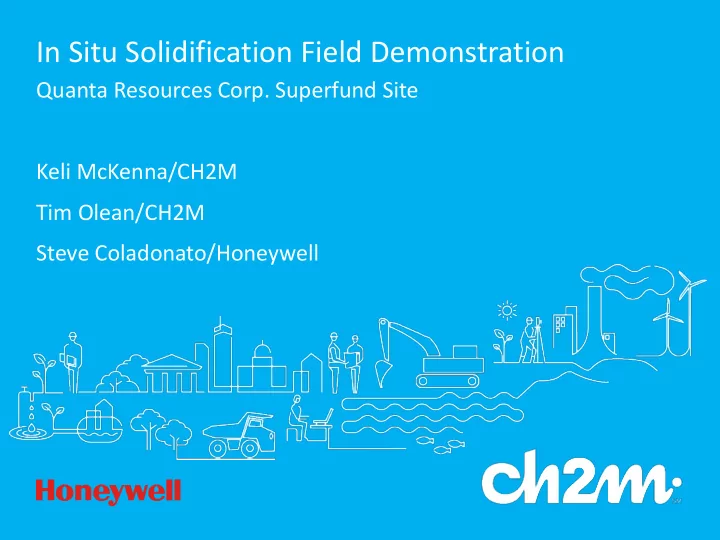

In Situ Solidification Field Demonstration Quanta Resources Corp. Superfund Site Keli McKenna/CH2M Tim Olean/CH2M Steve Coladonato/Honeywell
Agenda • Site Background • ROD Requirements • Bench Scale Treatability • Field Demonstration – Treatment Areas – Mixing Plan – Sampling Plan • Analytical Results • Conclusions 2
Site Location City Place Quanta 115 River Road Hudson River I.Park 3
Site Background • Former coal tar processing facility dating back to the late 1800s • Former industrial area experiencing upscale redevelopment • Coal tar NAPL, PAHs, and arsenic present in groundwater and soils • Remedial Investigation completed in 2010 • Feasibility Study completed in 2010 4
Record of Decision (ROD) Requirements Selected soil and NAPL remedy • – ISS for shallow “NAPL Zones” and arsenic (~130k CY total) – Supplemented by deep NAPL recovery, high- concentration arsenic stabilization, capping, institutional controls • ISS performance criteria – Unconfined Compressive Strength >40 psi – Permeability <1x10 -6 cm/s – Leaching reduction of 90% for majority of site constituents 5
ISS Treatment Areas 6
Bench Scale Treatability Testing • Nine boring locations across the site (11 total samples) • Baseline each sample – Particle size, bulk density, % moisture, – Total BTEX, PAH, and Arsenic – SPLP and 1314** BTEX, PAH, and Arsenic • Contractor prepare composites • Multi-phase approach testing a total of 13 mixes – 7 with only pozzalon reagents – 6 with pozzalons and additives – Overall total reagent dose ranged from 7.5 to 20 percent 7
Treatability Testing Conclusions • UCS, permeability, leaching reductions were comparable across the range of mixes evaluated. • Total pozzalon addition of 8 percent or greater met the ROD requirements – TARGET = 2% Portland + 6% slag • Incorporation of other additives (i.e. carbon, hydrated lime, Enviroblend, or calcium polysulfide) did not result in an improvement in the leaching reduction 8
Field Demonstration Test Objectives • Demonstrate consistency with the treatability test results to meet ROD requirements in the field using both auger-mixing and bucket-mixing techniques • Determine short-term construction parameters to be used during full-scale treatment • To further refine the understanding of reagent delivery • Evaluate feasibility of proposed debris management procedures including pile removal and management • Assess potential exposure risk to airborne contaminants through real-time monitoring and analytical sampling methods • Demonstrate the efficacy of odor and dust control mitigation methods 9
ISS Field Demonstration Locations Selected A-02 - Arsenic to 22 ft bgs Auger Mixed 390 cy Evaluated for multiple mixes AN-02 – Arsenic and NAPL to 15 ft bgs Bucket Mixed 148 cy (max depth 11.5 ft) N-04 – Worst case NAPL to 15 ft bgs Bucket Mixed 233 cy Attempted multiple mixes N-01 – Deepest NAPL to 25 ft bgs Auger Mixed 490 cy 10
ISS Field Demonstration Performed A-02 - Arsenic + Auger Alternative Mix 3.5% PC and 10.33% Slag Recommended Mix 2% PC and 6% Slag Alternative Mix 1.5% PC and 4.4% Slag 11
ISS Field Demonstration Performed AN-02 – Arsenic/NAPL + Bucket Bucket Mixing N-04 – NAPL + Bucket 12
ISS Field Demonstration Performed Auger Mixing N-01 – NAPL + Auger 13
Sample Collection & Analysis Samples from the 4 areas various depths • – 44 analyzed for UCS and permeability – 16 selected for 1315M leaching Sampling Tool with a Hydraulically-Controlled Sample Bucket 14
Performance Sampling Conformance Testing – to demonstrate consistency with the ROD requirements – UCS: reported on 28-day cured samples – Permeability: reported on 28-day cured sample – Leachability: Premethod 1315 (GRO; BTEX, PAHs, arsenic) reported on 28-day cured sample 15
Performance Sampling Consistency Testing - to monitor for variability in the mixed material and demonstrate construction quality control. – Pocket penetrometer testing performed on 1-, 3-, 5-, and 7-day cured samples – Slump test on freshly treated material – Moisture content and wet density – Alkalinity and pH – UCS: reported on 7- and 14-day cured samples 16
Analytical Results Evaluation - UCS 41 of 44 samples achieved ROD criteria (>40 psi) • • Median – 152 psi • Three samples < 40 psi at 28-day cure (28, 39, and 36 psi) – From auger locations and with <8% reagent – All samples >40 psi (185, 151, and 55 psi) when retested after longer cures (76, 77, and 82 days) 17
UCS vs. Time 18
Analytical Results Evaluation - Permeability 42 of 44 samples achieved ROD criteria (<1 x 10 -6 cm/s) • • Median = 3.55 x 10 -8 cm/s Two samples missed criteria (1.5 x 10 -6 cm/s and 1.8 x 10 -6 cm/s) • – From both auger locations and with <8% reagent • Permeability still much lower than surrounding material (10 -3 cm/s) 19
Samples Selected for Leaching Analysis 28-day Conformance Testing Planned Mix Actual Mix UCS Permeability Location Delivery Column # Depth Mix ID %PC % BFS %PC % BFS (psi) (cm/s) 1 0-5 FD-1 2 6 2 6 163 1.6E-08 2 5-10 FD-2 2 6 2 6 98 1.4E-08 N-4 Bucket 3 5-10 FD-3 2 6 2 6 209 3.1E-08 4 5-10 FD-4 2 6 2 6 153 3.7E-08 2 10-15 FD-5 2 6 2 5.9 50 3.7E-07 4 0-5 FD-6 2 6 2 6 54 5.9E-07 N-1 Auger 5 20-25 FD-7 2 6 2.1 6.3 56 6.9E-07 7 10-15 FD-8 2 6 2.1 6.4 104 1.2E-07 2 0-5 FD-9 2.5 7.5 3.5 10.33 332 1.2E-08 4 8.5-13.5 FD-10 1.5 4.5 1.5 4.4 83 3.6E-07 A-2 Auger 5 17-22 FD-11 1.5 4.5 1.5 6.5 89 1.4E-07 7 8.5-13.5 FD-12 2 6 2 6 361 1.4E-08 1 0-5 FD-13 2 6 3 9 650 5.8E-09 2 6-12 FD-14 2 6 3 9 740 1.6E-08 AN-2 Bucket 3 0-6 FD-15 2 6 3 9 777 7.3E-09 20 4 6-12 FD-16 2 6 3 9 875 6.5E-09
Example Leaching Calculation 21
Recommend
More recommend